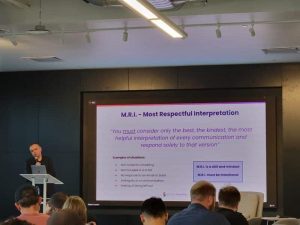
Goal-setting, for many people, seems tedious and boring. Just say the words, “We are having a goal-setting meeting,” and count the number of eyes that roll and the groans that vibrate through the room. Some might say that goal-setting puts you over a barrel, an idiom with origins arising from the action of being draped over a barrel to empty the lungs of someone drowning or to administer a flogging.
Goal-setting, however, can be a useful tool for keeping an organization relevant in the business world, especially when utilizing the potential of the human capital within your organization in order to complete the plan. As with any tool, goal-setting is only as useful as the people creating and implementing the process. Individuals who are engaged and interested create a better environment or culture to set goals. Creativity and open-thinking occur with motivated people.
To brings a new perspective to your goal-setting activities each member of the team can use this three-part process as a framework to achieve team goals that are focused, yet take into consideration the value of human potential. Remember in this process there is no good or bad, or wrong or right, only a focus on setting and achieving goals with open dialogue and critical thinking. Each part of the process works in cooperation with the other two parts, helping people maintain an intentional and accountable process for achieving goals:
Start with Awareness
Each member of the team should take the time to individually move beyond “the way we’ve always done it” thinking. Take the opportunity to stretch the imagination. With awareness comes possibilities. Encourage each person to gain knowledge by searching online to see how other people have completed the tasks you want to plan, complete a word search for topics related to the program. Write out ideas that come to mind. Stay intentional about documenting a list of all the possible objectives and different possibilities of the plan. The broader the selection of choices, the better chance you have of finding a broader perspective. Without awareness, you may not uncover an available opportunity.
Move Toward Discussion
Discussing the plan helps to verbalize thoughts. Pull together a group of people who are participating in the ultimate plan, or who have knowledge that could be valuable to the project. Encourage brainstorming. Document responses about ways to accomplish the project. Talking with other people, both within and outside of the team, helps people become engaged in the program and offers motivation for creating the plan. Make sure to set goals that your employees support. Nothing stops the process of setting goals more than an employee who does not see the value of the goal or the value of working with the team on a goal. The more engaged your employees are with the plan, the better chance for success. The discussions are an excellent opportunity to engage facilitators or use SWOT, SMART or more recently, ACTS to assess the possible goals and start building a framework for the ultimate plan. With discussions, the combined potential for the project expands as people create a practical framework.
Finish with Action
Solidify a final list of actions or objectives with assignments for people and timelines. A project manager or a project program, such as Microsoft Project and Gantt Charts helps keep the plan moving forward. All too often, with goal-setting, people leave the discussions without a timeline or a way to manage the project. Maintaining schedules may seem rudimentary, however, how many times have you been at a goal-setting event that ends with a nice feeling, but little accomplished a year later? During the implementation of the plan use some positive reinforcement to maintain a higher level of enthusiasm for the project. Reinforcements for successful completion of timelines could include activities such as emails thanking people for their part in completing the task on time, small gift cards for drink shops so individuals can take a quick run to get their favorite beverage. Team reinforcements, when completing a large part of the project, could include such activities as taking lunch orders for a particular meal, or afternoon drink table, whatever matches the personality of your team. The important thing with these reinforcements is to make sure that they are items or activities that have value for the individuals. You may have to invest a little time in learning more about you team, but in the end, you will gain valuable time with the engagement of employees as they invest in the project.
The goal of goal-setting is to bring cohesion to an organization with some intentional direction and active participation. When you combine motivated people with business goals, you have the potential to create a fully completed and deliberate plan for success.
Business & Finance Articles on Business 2 Community(66)
Report Post





